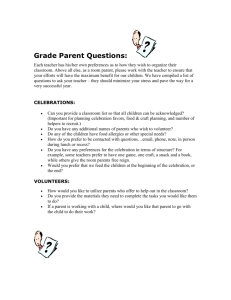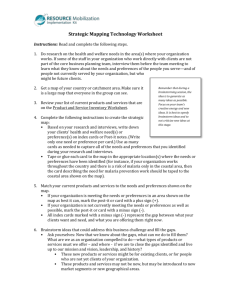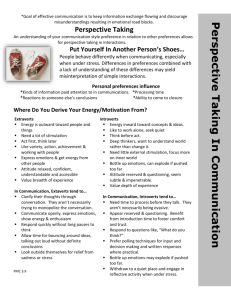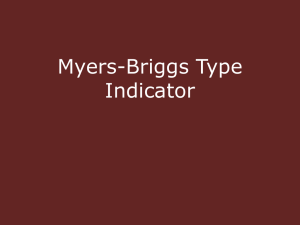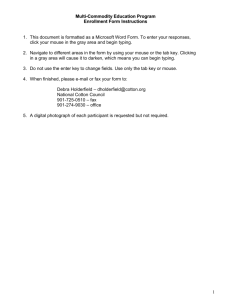"How to Differentiate Instruction in Mixed-Ability
advertisement
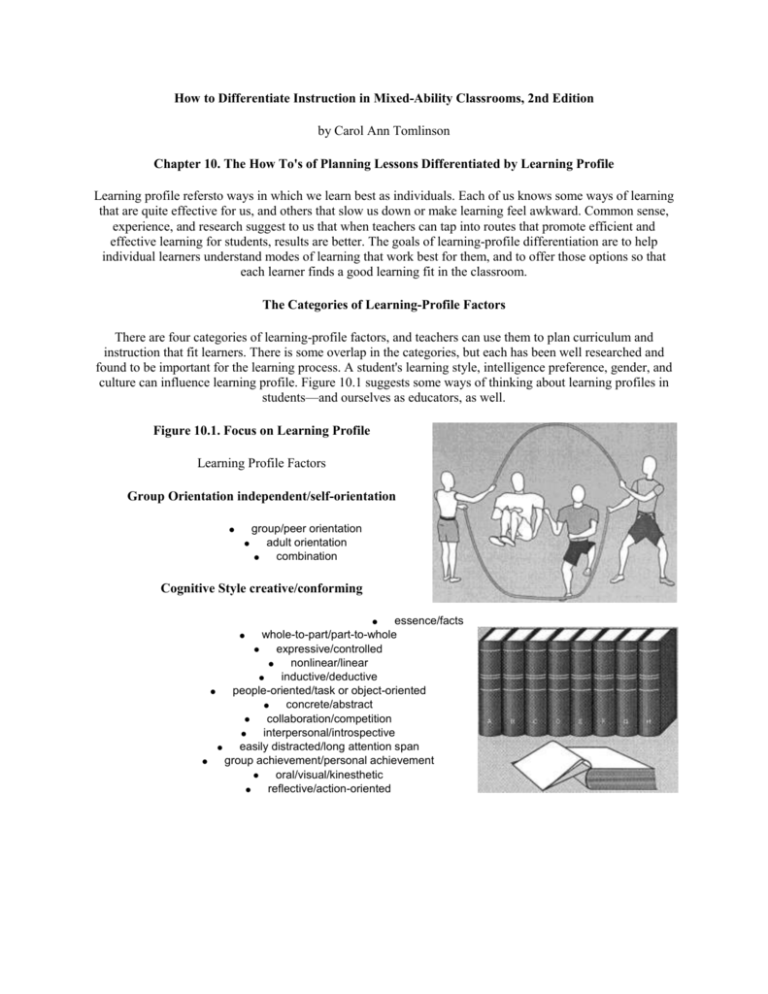
How to Differentiate Instruction in Mixed-Ability Classrooms, 2nd Edition by Carol Ann Tomlinson Chapter 10. The How To's of Planning Lessons Differentiated by Learning Profile Learning profile refersto ways in which we learn best as individuals. Each of us knows some ways of learning that are quite effective for us, and others that slow us down or make learning feel awkward. Common sense, experience, and research suggest to us that when teachers can tap into routes that promote efficient and effective learning for students, results are better. The goals of learning-profile differentiation are to help individual learners understand modes of learning that work best for them, and to offer those options so that each learner finds a good learning fit in the classroom. The Categories of Learning-Profile Factors There are four categories of learning-profile factors, and teachers can use them to plan curriculum and instruction that fit learners. There is some overlap in the categories, but each has been well researched and found to be important for the learning process. A student's learning style, intelligence preference, gender, and culture can influence learning profile. Figure 10.1 suggests some ways of thinking about learning profiles in students—and ourselves as educators, as well. Figure 10.1. Focus on Learning Profile Learning Profile Factors Group Orientation independent/self-orientation group/peer orientation adult orientation combination Cognitive Style creative/conforming essence/facts whole-to-part/part-to-whole expressive/controlled nonlinear/linear inductive/deductive people-oriented/task or object-oriented concrete/abstract collaboration/competition interpersonal/introspective easily distracted/long attention span group achievement/personal achievement oral/visual/kinesthetic reflective/action-oriented Learning Environment quiet/noise warm/cool still/mobile flexible/fixed “busy”/“spare” Intelligence Preference analytic practical creative verbal/linguistic logical/mathematical spatial/visual bodily/kinesthetic musical/rhythmic interpersonal intrapersonal naturalist existential Learning-Style Preferences Learning style refers to environmental or personal factors. Some students may learn best when they can move around, others need to sit still. Some students enjoy a room with lots to look at, color, things to touch and try out. Other students function best when the environment is more “spare” because they find a “busy” classroom distracting. Some students need a great deal of light in a room in order to feel comfortable. Other students prefer a darker room. Some students will learn best through oral modes, others through visual channels, still others through touch or movement. Although a teacher cannot manipulate all these elements, and other learning style components, all the time, it is possible for a teacher to give students some learning choices. It's also possible for a teacher to create a room with different “looks” in different portions of the room, or with differing working arrangements. Intelligence Preferences Intelligence preference refers to the sorts of brain-based predispositions we all have for learning. Two theorist/researchers have proposed ways of thinking about intelligence preferences. Howard Gardner (1993) suggests that we each have varying strengths in combinations of intelligences he calls verbal linguistic, logical mathematical, visual spatial, musical rhythmic, bodily kinesthetic, interpersonal, intrapersonal, and naturalistic—and perhaps existential. Robert Sternberg (1985) suggests that we all have varying strengths in combinations of intelligences he refers to as analytic (schoolhouse intelligence, preference for learning in linear ways often typical of school), practical (contextual intelligence, preference for seeing how and why things work in the world as people actually use them), and creative (problem-solving intelligence, preference for making new connections, innovation). Indications are that when students approach learning in ways that address their intelligence preferences, results are quite positive. Culture-Influenced Preferences Culture affects how we learn, as well. It can influence whether we see time as fixed and rigid or flexible and fluid, whether we are more effusive or reserved in expressing emotions, whether we learn best in a whole-topart or a part-to-whole approach, whether we prefer to learn material that's contextual and personal or discrete and impersonal, whether we prefer to work with a group or individually, whether we most value creativity or conformity, whether we are more reflective or more impulsive—and many other preferences that can greatly affect learning. Also some learning patterns may differ from one culture to another; there is huge learning variance within every culture. The goal of the teacher is, therefore, not to suggest that individuals from a particular culture ought to learn in a particular way, but rather to come to understand the great range of learning preferences that will exist in any group of people and to create a classroom flexible enough to invite individuals to work in ways they find most productive. Gender-Based Preferences Gender also influences how we learn. As is the case with culture, there are learning patterns in each gender— but great variance, as well. Whereas more males than females may prefer competitive learning, for example, some males will prefer collaborative learning and some females will prefer competition. Some of the same elements that are influenced by culture can also be influenced by gender (for example, expressiveness versus reserve, group versus individual orientation, analytic versus creative or practical thinking, and so on). Combined Preferences Combinations of culture and gender will create unique constellations of learning preferences in individuals. Patterns of learning preference are certainly complex when we look at an individual's learning style; intelligence; culture-influenced, gender-influenced preferences. A sensitive teacher understands that her students may have learning preferences much like or much different than that of the teacher and tries to create options and choices that make everyone comfortable much of the time. Some Guidelines for Learning-Profile Differentiation Though there is no single way of ensuring that students get to learn in ways that work best for them, some guidelines are broadly useful in establishing classrooms responsive to a wide range of learning preferences. Remember that some, but not all, of your students share your learning preferences. For example, if you are a highly auditory learner, you may be prone to be an auditory teacher, as well. That's great for kids who learn like you do, but not great for kids with visual or kinesthetic learning preferences. If you were successful in school, you may find analytic and part-to-whole learning a breeze. Some students in your class will like those approaches as well, but students who need more creative, contextual, and whole-to-part approaches may feel like they are working in a fog unless you stretch your own comfort zone and teaching repertoire. Help your students reflect on their own preferences. Give your students a vocabulary of learning-profile options. Let them know you're offering creative, practical, and analytic learning choices today—or that you've intentionally created both competitive and collaborative study formats—or that you're making a connection between whole-to-part (global, big idea) and part-towhole (detail) portions of today's lab. Then invite students to talk about which approaches make learning most natural and effective for them. That's also a good opportunity to help students realize that not everyone in the class learns the same way, and that a good teacher works hard to honor many routes to learning, rather than only one. Use both teacher-structured and student-choice avenues to learning-profile differentiation. Sometimes it's really effective for a teacher to think about using several intelligences as ways for students to explore or express ideas. Often, only the teacher can ensure flexible use of time or combination of presentation modes. Even when a teacher does not have time to structure or craft several learning-profile options for a lesson, much can be accomplished by asking students to make their own choices. Students can select modes of expression and decide whether to work alone or with a peer, to sit in a desk or curl up on the floor with a book, to accept inevitable classroom sounds or screen them out by using earplugs or headphones, and so on. When students are partners with teachers in making the learning environment a good fit, more is accomplished with less strain on the teacher. Select a few learning-profile categories for emphasis as you begin. We know a great deal about learning preferences—so much, in fact, that it can seem overwhelming. As you begin to differentiate your instruction in response to a range of learning-profile needs, select a few categories to emphasize in your planning. You may, for example, work with Sternberg's (1985) three intelligences as you create tasks; using both contextual and factual illustrations for your students, you may employ both visual and auditory approaches to sharing information with your students. That's enough to begin. Then, whenever possible, offer your students learning decisions that they can make to further craft the classroom to match their learning needs. Be a student of your students. It's very hard to “get inside someone else's skin.” It's devilishly difficult to see life as someone who experiences the world differently than you do. We particularly fail many students whose cultural background is different from our own. It's essential to watch individuals in your class for learning clues, to talk with them about what works and doesn't work for them, and to invite them to make suggestions or pose alternatives that seem more promising. It's also useful to ask parents to provide insights into what works, or doesn't, when their students learn. If we can expand our vision beyond the parameters of our own private universe, we become more welcoming and effective teachers of children who inevitably inhabit private universes different from our own. A Glimpse at Strategies That Support Learning-Profile Differentiation There are numerous instructional strategies that help us focus on students' learning-profile needs. Figure 10.2 lists a number of them. Here are brief explanations of a few strategies helpful in differentiating instruction in response to students' learning profiles. Figure 10.2. Strategies That Support Learning-Profile Differentiation Vary Teacher Presentation auditory visual kinesthetic whole-to-part part-to-whole Vary Student Mode of Expression Gardner's 8 or 9 intelligences Sternberg's 3 intelligences Working Choice Arrangements 4-Mat Flexible Environment Complex Instruction Multiple Modes of Assessment Organizers Varied Approaches to Organizing Ideas and Information Entry Points Complex Instruction. This powerful strategy emphasizes teachers studying their students to determine which intellectual strengths each student brings to the classroom. The teacher then designs high-level, complex learning tasks that draw on the intellectual strengths of each student in a collaborative group (Cohen, 1994). Entry Points. It is possible to encourage students to enter a topic or explore it through a learning preference (Gardner, 1993), thus making early experiences a good fit. Entry point explorations can be narrational (telling a story), quantitative (scientific approaches), foundational (looking at beliefs or frameworks of meaning at the core of the topic), aesthetic (sensory, arts-based approaches), or experiential (hands-on, personal opportunities to become involved). 4-MAT. This approach to planning suggests that varied learners would prefer (1) mastery of information, (2) understanding of key ideas, (3) personal involvement, or (4) creating something new related to a topic. A teacher using 4-MAT plans lesson sequences on a given topic in which each of the four preferences is stressed. This ensures that every student experiences the topic through a preferred approach and also has opportunities to strengthen learning in less preferred modes (McCarthy, 1996). Varied Approaches to Organizing Ideas. It's important that students organize their thinking so they can make sense of ideas, communicate clearly, and retain and retrieve information. Often it's less important which approach to organization a student uses than that they have an organizational approach that works for them. When there's no compelling reason why all students must use the same organizational approach, encourage students to select from strategies such as summarizing, mind-mapping, concept mapping, storyboarding, or outlining. Of course, you'll have to ensure that all students understand the various options; but once that's accomplished, you'll quickly see some students gravitate to one approach while other students make different decisions. It's likely to be a learning-profile issue. Using Learning Profile to Differentiate Content, Process, and Product As is true for readiness and interest, attending to learning profile provides teachers with a way to differentiate content, process, and product. Here are some examples. *** Ms. Lide sometimes differentiates content in ways likely to tap in to student-learning profile. She tape-records key materials (or has others do the recording) so that auditory learners can listen rather than being solely dependent on visual contact with materials. She also sometimes uses role-play just after the students have completed reading, asking students to volunteer to act out what they have read. She finds that kinesthetic learners like this more physical approach to comprehension. When introducing ideas to her students, she makes sure to use graphic organizers to show them how parts of their study fit the big picture of meaning. She also makes certain that she uses an overhead projector or flip chart as she talks so that students can hear and see ideas. *** In differentiating process or activities, Mr. Larsen uses what he calls Menus for Success. He might, for example, offer students four ways to explore a math concept today. One approach might ask students to use words and pictures to create directions for how to solve the kind of problem that's the focus of the unit. A second approach might provide multiple versions of the problem to practice, with the opportunity to check answers for accuracy as they go along. A third option might entail students investigating how the kind of math problem could be used to solve a real-life dilemma. A fourth approach might ask students to use manipulatives and words to demonstrate how the problem type works. Whatever the student's selection, they then decide whether they work more effectively alone or with a peer. Mr. Larsen talks with students about learning to make wise selections from the Menu for Success to support healthy learning, just as they would from a restaurant menu to support healthy living. *** In differentiating products in response to student learning profile, Ms. Michaels uses several approaches. Because she believes her goal is to assess student growth in ways that let each student show how much they know, understand, and can do, she often uses more than one kind of end-of-unit assessment. She may combine tests and portfolios of student work. This lets her work with students on effective test taking, but also enables students for whom test taking is difficult or uninspiring to show how much they've learned in a more comfortable format. When she creates product assignments for students, she nearly always provides at least two or three choices of how students can express what they have learned—for example, through a museum exhibit that includes models and narratives, through an essay or dialogue, or through an annotated and illustrated time line. She also tries to vary research materials to include artifacts, visuals, print materials, interviews, and technology. She varies working arrangements so students sometimes work alone, sometimes with peers, and sometimes in whichever format they prefer. There are many ways to accommodate students' preferred ways of learning. Looking for a good learning fit for students means, at least in part, trying to understand how individuals learn and responding appropriately. Bringing the Elements Together In the early stages of differentiation, it's helpful to think about using student readiness, interest, and learning profile to differentiate content, process, and product. Breaking down the task into elements not only lets us focus on smaller and more manageable pieces of teaching, but can also help us assess the degree to which we are looking broadly or narrowly at addressing students' learning needs. In the end, however, the goal is to have a flow of differentiation so that much of what we do is a fit for each student much of the time (see figures 10.3 and 10.4). That means our goal is to bring together the elements we can differentiate and ways we can go about differentiating them so that there is wholeness to what we do. Figure 10.3. Before and After: The Flow of Instruction (A Secondary Example) Figure 10.4. Before and After: The Flow of Instruction (A Math Example) A teacher whose skills of differentiation are fluid continually asks, “Would students benefit from flexibility in approaching today's learning goals?” When the answer is yes, the teacher seeks alternative avenues to learning for her students, and invites them to join her in that quest. (see figure 10.5 for sample diagnostic questionnaires). Here's a brief example of an elementary teacher's classroom in which differentiation is pervasive.
